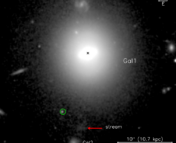Title: GRB 180418A: A possibly-short GRB with a wide-angle outflow in a faint host galaxy
Authors: Alicia Rouco Escorial, Wen-fai Fong, Peter Veres, et al.
First author’s institution: Northwestern University
Journal: Submitted to the Astrophysical Journal. Open access on ArXiv.
Disclaimer: The author would first like to publicly state that Black lives and Black Trans lives matter. Secondly, the author condemns all police brutality against people of color. Lastly, the author recognizes that the writing of this article was performed on the stolen land of indigenous people.
High Energy Enigma
Astronomers, especially those studying stellar explosions, can’t help but discover strange things. While bizarre phenomena may seem unlikely to help astronomers find order in the universe, these discoveries are crucial to how we create physical models to characterize astrophysical occurrences. Such is the case with today’s paper on a peculiar gamma-ray burst (GRB) whose unique observational signatures challenged the status quo while also highlighting the amazing potential of unique transient events.
Gamma-ray bursts are the most energetic, and short-lived, events in the known universe. Currently, astronomers classify these fleeting stellar outbursts based on how long they visibly emit gamma-ray photons, resulting in two distinct classes: short and long GRBs. Short GRBs release ~90% of their gamma-ray flux in less than 2 seconds (!) and are thought to be caused by the violent merger of two neutron stars. This is contrasted by long GRBs which can last for minutes to hours and are likely the result of the collapse of a particular type of massive star. Figure 1 shows a sample of previously discovered GRBs with GRB 180418A landing squarely in the middle of the distribution of burst duration – possibly short, possibly long, definitely weird!
Finding Common Ground
After demonstrating how GRB 180418A did not fit the classic distribution of GRB timescales, the authors used long-term observations across the electromagnetic spectrum in order to probe this explosion’s origins. As shown in Figure 2, this GRB was imaged in optical wavelengths for hundreds of days after detection. This follow-up campaign allowed the authors to model the physics of the explosion as well as derive properties of the galaxy that hosted GRB 180418A. The authors showed that this burst originated from a faint galaxy in the distant universe at a redshift of ~1-1.5 (~8 BILLION years ago!).
As plotted in Figure 3, the observational campaign highlighted in today’s paper also included multiple detections of X-rays from GRB 180418A that were brighter and which lasted for a longer time than X-rays from typical short GRBs. While long-lived X-ray emission is more commonplace in long GRBs, modeling of the data indicated that the opening angle of this GRB’s jet was quite large, unlike those observed in most long GRBs. This intriguing revelation is most consistent with the known opening angles of short GRBs despite the long X-ray timescale.
These observations reinforce the fact that GRB 180418A exists at the fringe of both GRB populations: it is either the one of the brightest short GRBs ever discovered or this explosion represents a low-luminosity addition to the family of long GRBs originating from the tumultuous collapse of a massive star. Either way, the ambiguities of this fascinating object both challenge previous binary classifications of GRBs as well as indicate new ways to probe the complex origins of these spectacular stellar explosions.
Edited by: Kaitlyn Shin
Featured Image Credit: NASA/GSFC




